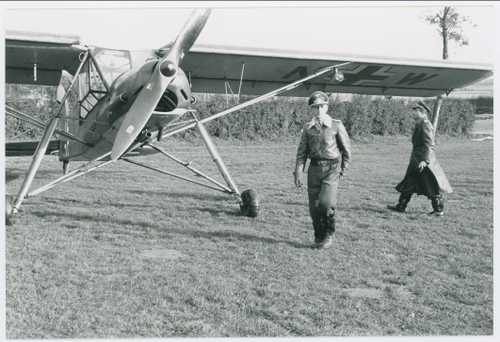
German Air Force
Oberstleutnant Werner Mölders
fbbrummbar
This is an extremely rare of image of Oberstleutnant Werner Mölders (with Oberstleutnant Friedrich Beckh walking behind him) taken just a few weeks after his appointment to Commanding Officer of JG51, at Saint-Inglevert Airfield, in the summer of 1940. He is seen standing in front the groups Fieseler Fi 156 Storch 'N + W' moments after landing. Mölders joined the Luftwaffe, in 1934. In 1938, he volunteered for service in the Condor Legion, which supported General Franco in the Spanish Civil War, and shot down 14 aircraft. With the start of World War II, he took part in the "Phoney War", the Battle of France, and the Battle of Britain. With his tally standing at 68 victories, Mölders and his unit, Jagdgeschwader 51 (JG 51), were later transferred to the Eastern Front in June 1941 for the opening of 'Operation Barbarossa', he then achieving 101 victories by mid-July 1941. He was then prevented from flying any further combat missions, being used constantly as a highly decorated propaganda image, despite his objections. Thus, at the age of 28 Mölders was appointed 'Inspector of Fighters' to keep him in a safe active role, and to maintain morale. He was inspecting the Luftwaffe units in Crimea when he was suddenly ordered to Berlin to attend the state funeral of Ernst Udet, a Luftwaffe general and World War I flying ace. He was to be part of an Honour Guard that was full of elite pilots, including Adolf Galland. On the flight to Berlin, the aircraft in which he was travelling as a passenger attempted an emergency landing in bad weather due to an engine failure. It crashed at Breslau, killing Mölders and two others. On 22 November 1941, Mölders travelled as a passenger in a Heinkel He 111 of Kampfgeschwader 27 "Boelcke" from the Crimea to Germany to attend the funeral of his superior, Ernst Udet, who had committed suicide when his girlfriend left him. Attempting to land at Breslau during a heavy thunderstorm, the aircraft crashed. Mölders, pilot Oberleutnant Kolbe and flight engineer Oberfeldwebel Hobbie were all killed. Major Dr. Wenzel and radio operator Oberfeldwebel Tenz survived the crash landing. Dr. Wenzel sustained a broken arm and leg as well as a serious concussion, and Tenz a broken ankle. Mölders' fatal injuries included a broken back and a crushed rib-cage. Accident investigators then and since have speculated that Mölders would have most likely survived the crash if he had used his seat belt. The Wehrmacht and the West German Bundeswehr both honoured him by naming two fighter wings, a destroyer, and a barracks after him. In a cynical move 1998, the German Parliament decided that members of the Condor Legion such as Mölders, should "no longer be honoured" despite being national heroes, superb pilots, and not being members, of, the then, National Socialist Party. In 2005, the German Ministry of Defence shamefully decided to also remove the name "Mölders" from the remaining fighter wing still bearing his name in his honour! taken from fb/Official world war 2 historians & buffs
3560 Views
8/16/2020
